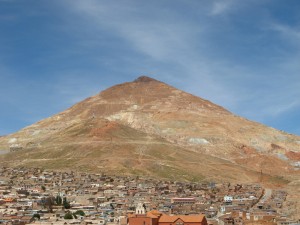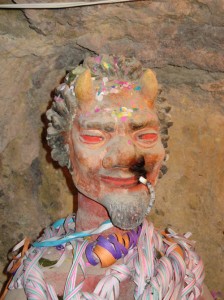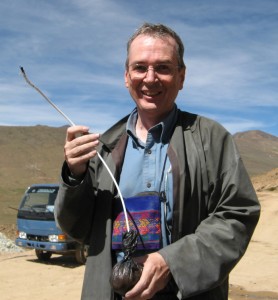Potosi in Bolivia sits below the Cerro Rico mountain, which is a treasury of metallic ores and riddled with mines. During the Spanish colonial period it was a fabulously wealthy silver mine, generating vast fortunes for the Spanish Crown.
The mine is still mostly hand worked. I took a small group tour with Koala Tours (recommended by LonelyPlanet). The tour involved a fair amount of talking, standing around, buying supplies, visiting an ore refinery, etc, but we also got a good two and a half hours underground. The city is at a heady 13,000 feet up the Andes and the mine entrances are higher.
Potosi now produces mostly zinc, with some tin and only a little silver. World zinc prices rose dramatically two years ago and so the Potosi miners are prospering. They have very large incomes by Bolivian standards and are buying 4 wheel drive trucks, etc. But they still have very poor life expectancies (as low as 38?) mostly due to silicosis. Miners typically start at 15, with some starting at 10 or 12.
The mining is all done by small (100-200 people) competing cooperatives with no coordination between cooperatives and very little concern for safety. Mines can easily run into one another (and fight) or undermine one another. The mountain is slowly being hollowed out and may eventually collapse. The optimal solution for the whole mountain would probably be to move to open cast mining and level the thing, but the cooperatives oppose this, as they would lose their livelihoods. They reckon it is better to have desperately harsh but profitable jobs, rather than to have nothing.
Most work is still done by hand. In the mine we visited, they loosen the rock by blasting, hand-shovel it out, move mine trucks by pushing and pulling by hand, and hand-shovel the ore in and out of big baskets for mechanical winching between levels. We didn’t see the mining face (too dangerous) but we saw shoveling, winching, and trucking.
We had stopped at a supply store to buy gifts for the miners, including soda, coca leaves, dynamite and fuses. (Note: you have to be at least 12 to buy dynamite.)
We visited a rather touristy in-mine museum, with a touristy statue of El Tio, the lord of the mines. (The miners are all good Catholics above ground, but they perhaps wisely regard below ground as belonging to Someone Else.)
We then went down two levels, the first being 25 meters, the second less. Within a level, most of the travel was through the railed tunnels for the trucks, which was easy going, with only occasional crawls. But between levels, we scrambled up fairly narrow, steep, irregular passages. Our guide explained that when he was younger they used to have to carry the ore out on their backs, up these steep passages.
By the standards of CUCC, this would have been a very easy cave, but at 13,000 feet, the climbs up felt like very hard work. I was very definitely out of puff and breathing very hard after the second climb. But it was good fun!
I was in a group of eight visitors plus two guides. Most of the others were young students and I think I was twice the average age. ☺ After we got out, the students had kept back one tube of dynamite. So we got to wad it up, (it felt like putty), light the fuse (naturally we passed around the dynamite with lit fuse for photos) and then our guides put it in a field, waved us back, and we watched the explosion. Loud, but not outrageous.
Later, after a shower, we visited the rather dull refinery of San Marco. There was some refining machinery, but it was much less impressive than the mine tour.


